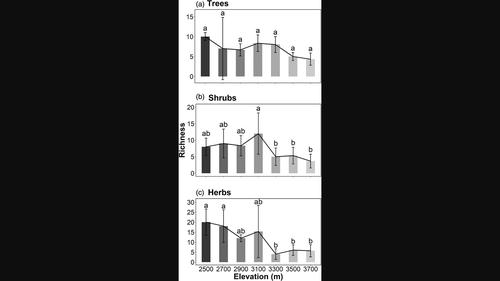当前位置:
X-MOL 学术
›
Ecol. Res.
›
论文详情
Our official English website, www.x-mol.net, welcomes your feedback! (Note: you will need to create a separate account there.)
Taxonomic and phylogenetic perspectives reveal the community assembly of different forest strata along an altitudinal gradient
Ecological Research ( IF 2 ) Pub Date : 2023-09-08 , DOI: 10.1111/1440-1703.12420 Jiamin Wan 1 , Yang Chen 1 , Yanpeng Li 1, 2, 3 , Caicai Zhang 1, 2, 3 , Zhipang Huang 1, 2, 3 , Wen Xiao 1, 2, 3
Ecological Research ( IF 2 ) Pub Date : 2023-09-08 , DOI: 10.1111/1440-1703.12420 Jiamin Wan 1 , Yang Chen 1 , Yanpeng Li 1, 2, 3 , Caicai Zhang 1, 2, 3 , Zhipang Huang 1, 2, 3 , Wen Xiao 1, 2, 3
Affiliation

|
Disentangling the distribution patterns of biodiversity along altitudinal gradients and their drivers has been a hot topic in ecological research. Different forest strata show multiple distribution patterns influenced by different community assembly mechanisms. Here, we measure the dominant ecological processes affecting three forest strata (tree, shrub, and herb layers) along altitudinal gradients. We sampled plants with different forest strata in 21 plots located from 2500 to 3700 m in Lasha Mountain, northwestern Yunnan. The taxonomic alpha diversity of the herb layer showed a monotonic decreasing trend with increasing altitude, while the shrub layer was characterized by a single peak, and the tree layer showed no significant change with increasing altitude. We observed a decreasing pattern of phylogenetic diversity with increasing altitude in the herb layer, whereas phylogenetic diversity did not change in the tree and shrub layers. The phylogenetic structure of these three layers showed the same pattern: phylogenetic clustering at low altitudes and overdispersion at middle and high altitudes. The diversity and phylogenetic structure of the herb layer were driven by climate (average dry season precipitation) and topographic (slope and aspect) factors, while shrub layer diversity was mainly influenced by tree layer richness. Overall, the phylogenetic structure pattern of the three forest strata changed from clustered to overdispersed with increasing altitude, indicating that environmental filtering was the main driver at low altitudes, while interspecific competition dominated at middle and high altitudes.
中文翻译:

分类学和系统发育的角度揭示了不同森林层沿海拔梯度的群落组装
解开生物多样性沿海拔梯度的分布模式及其驱动因素一直是生态研究的热门话题。受不同群落组装机制的影响,不同的森林层呈现出多种分布格局。在这里,我们沿着海拔梯度测量影响三个森林层(树木、灌木和草本层)的主要生态过程。我们在滇西北拉刹山海拔2500~3700 m的21个样地中对不同林层的植物进行了采样。草本层分类α多样性随海拔升高呈单调递减趋势,灌木层呈单峰特征,乔木层随海拔升高无显着变化。我们观察到草本层的系统发育多样性随着海拔的增加而减少,而树木和灌木层的系统发育多样性没有变化。这三层的系统发育结构表现出相同的模式:低海拔系统发育聚类,中高海拔过度分散。草本层的多样性和系统发育结构受气候(平均旱季降水量)和地形(坡度和坡向)因素驱动,而灌木层多样性主要受乔木层丰富度影响。总体而言,随着海拔的升高,三个森林层的系统发育格局由聚集向过度分散转变,表明低海拔地区环境过滤是主要驱动力,而中高海拔地区种间竞争占主导地位。
更新日期:2023-09-08
中文翻译:

分类学和系统发育的角度揭示了不同森林层沿海拔梯度的群落组装
解开生物多样性沿海拔梯度的分布模式及其驱动因素一直是生态研究的热门话题。受不同群落组装机制的影响,不同的森林层呈现出多种分布格局。在这里,我们沿着海拔梯度测量影响三个森林层(树木、灌木和草本层)的主要生态过程。我们在滇西北拉刹山海拔2500~3700 m的21个样地中对不同林层的植物进行了采样。草本层分类α多样性随海拔升高呈单调递减趋势,灌木层呈单峰特征,乔木层随海拔升高无显着变化。我们观察到草本层的系统发育多样性随着海拔的增加而减少,而树木和灌木层的系统发育多样性没有变化。这三层的系统发育结构表现出相同的模式:低海拔系统发育聚类,中高海拔过度分散。草本层的多样性和系统发育结构受气候(平均旱季降水量)和地形(坡度和坡向)因素驱动,而灌木层多样性主要受乔木层丰富度影响。总体而言,随着海拔的升高,三个森林层的系统发育格局由聚集向过度分散转变,表明低海拔地区环境过滤是主要驱动力,而中高海拔地区种间竞争占主导地位。



























 京公网安备 11010802027423号
京公网安备 11010802027423号